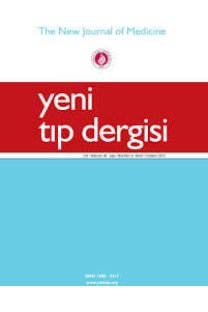Endoservikal küretaj: Minimal servikal sitolojik anormalliklerde kolposkopik muayene normal ve yeterli olduğunda
Endocervical curettage: Minimal cervical cytological abnormalities when colposcopic examination is satisfactory and normal
___
- 1. American College of Obstetricians and Gynecologists. Cervical cytology: Evaluation and management of abnormalities. ACOG technical bulletin no. 183. Washington, DC: American College of Obstetricians and Gynecologists 1993.
- 2. Drescher CW, Peter WA, Roberts JA. Contribution of endocervical curettage in evaluating abnormal cervical cytology. Obstet Gynecol 1983; 62:3437.
- 3. Saltzman DH, Evans MI, Warsof SL, Friedman AJ. Endocervical curettage as a routine part of colposcopic examinations for abnormal cervical cytology. J Reprod Med 1985;30:8713.
- 4. Hatch KD, Shingleton HM, Orr JW Jr, Gore H, Soong SJ. Role of endocervical curettage in colposcopy. Obstet Gynecol 1985;65:4038.
- 5. Townsend DE, Ostergard DR, Mishell DR, Hirose FM. Abnormal Papanicolaou smears evaluation by colposcopy, biopsies, and endocervical curettage. Am J Obstet Gynecol 1970;108:42934.
- 6. Urcuyo R, Rome RM, Nelson JH. Some observations on the value of endocervical curettage performed as an integral part of colposcopic examination of patients with abnormal cervical cytology. Am J Obstet Gynecol 1977;128:78791.
- 7. Swan RW. Evaluation of colposcopic accuracy without endocervical curettage. Obstet Gynecol 1979;53:6804.
- 8. Ronk DA, Jimerson GK, Merrill JA. Evaluation of abnormal cervical cytology. Obstet Gynecol 1977;49:5816.
- 9. Oyer R, Hanjani R. Endocervical curettage: Does it contribute to the management of patients with abnormal cervical cytology? Gynecol Oncol 1986;25:20411.
- 10. Wright TC, Massad LS, Dunton CJ Spitzer M, Wilkinson EJ, Solomon D. 2006 consensus guidelines for the management of women with abnormal cervical cancer screening tests. Am J Obstet Gynecol 2007;197:34655.
- 11. Driggers RW, Zahn CM. To ECC or not to ECC: the question remains. Obstet Gynecol Clin North Am 2008;35:58397.
- 12. Pretorius RG, Zhang WH, Belinson JL, et al. Colposcopically directed biopsy, random cervical biopsy, and endocervical curettage in the diagnosis of cervical intraepithelial neoplasia II or worse. Am J Obstet Gynecol 2004; 191:4304.
- 13. Ferenczy A. Endocervical curettage has no place in the routine management of women with cervical intraepithelial neoplasia: debate. Clin Obstet Gynecol 1995;38:6448.
- 14. Irvin W, Flora S, Andersen W, Stoler M, Taylor P, Rice L. Endocervical curettage. Does it contribute to the management of patients with abnormal cervical cytology? J Reprod Med 2004;49:17.
- 15. Noller KL. Endocervical curettage: a technique in search of an indication?: debate. Clin Obstet Gynecol 1995;38:64952.
- 16. Massad LS, Collins YC. Using history and colposcopy to select women for endocervical curettage: results from 2,287 cases. J Reprod Med 2003; 48:16.
- 17. Solomon D, Stoler M, Jeronimo J, Khan M, Castle P, Schiffman M. Diagnostic utility of endocervical curettage in women undergoing colposcopy for equivocal or low-grade cytologic abnormalities. Obstet Gynecol 2007;110:28895.
- 18. Gage JC, Duggan MA, Nation JG, Gao S, Castle PE. Detection of cervical cancer and its precursors by endocervical curettage in 13,115 colposcopically guided biopsy examinations. Am J Obstet Gynecol 2010; 203:481.e19.
- 19. Spirtos NM, Schlaerth JB, dAblaing G III, Morrow CP. A critical evaluation of the endocervical curettage. Obstet Gynecol 1987;70:72933.
- 20. Ostergard R, Gondos B. Outpatient therapy of preinvasive cervical neoplasia: Selection of patients with the use of colposcopy. Am J Obstet Gynecol 1973;115:7835.
- 21. Morrow CP, Townsend DE. Synopsis of gynecologic oncology. 3rd ed. New York: John Wiley & Sons, 1987.
- 22. Williams DL, Dietrich C, McBroom J. Endocervical curettage when colposcopic examination is satisfactory and normal. Obstet Gynecol 2000; 95:8013.
- ISSN: 1300-2317
- Yayın Aralığı: 4
- Başlangıç: 2018
- Yayıncı: -
İzole Hemihipertrofili Bir Olgunun Sunumu
Fesih AKTAR, Ali GÜNEŞ, Murat BAŞARANOĞLU, Mehmet Selçuk BEKTAŞ, Zehra DOĞAN
Sevim ÇELİK KARAKAŞ, Nurcan ATEŞ ARAS, MERAL URHAN KÜÇÜK, Serap YALIN, Esen AKBAY
Transkanaliküler diod lazer dakriyosistorinostomi sonuçlarımız
Sibel ÖSKAN, Sinan ÇALIŞKAN, Ayşe Yeşim ORAL AYDIN
Hint Kınası ile Yapılan Geçici Dövmeye Bağlı Lokalize Hipertrikoz: Bir Olgu
Havva AKIŞ KAYA, Bengü CEMİL ÇEVİRGEN, Filiz CANPOLAT, Müzeyyen GÖNÜL
Hiperemezis gravidaruma güncel yaklaşımlar
DEHA DENİZHAN KESKİN, SEDA KESKİN, Ezgi GÜNGÜL ERDOĞAN, Özhan ÖZDEMİR, Oğuz YÜCEL
Fibular hemimelili olgunun prenatal sonografik teşhisi
Zeynep İlerisoy YAKUT, Ali İPEK, Hatice AKKAYA
Yenidoğan yoğun bakım ünitelerinde iyatrojeni kavramına güncel bir bakış açısı
Mehmet Nevzat ÇİZMECİ, MEHMET KENAN KANBUROĞLU, Mustafa Mansur TATLI
Hülya Sayılan ŞEN, Zafer SALCIOĞLU, Arzu AKÇAY, Deniz TUĞCU, Gönül AYDOĞAN, Ferhan AKICI, Nuray Aktay AYAZ, zafer BAŞLAR
İHSAN YILMAZ, Abdullah ÖZKAYA, Ercüment ÇAVDAR, Zeynep ALKIN, Ebru Demet AYGIT, Korhan FAZIL
